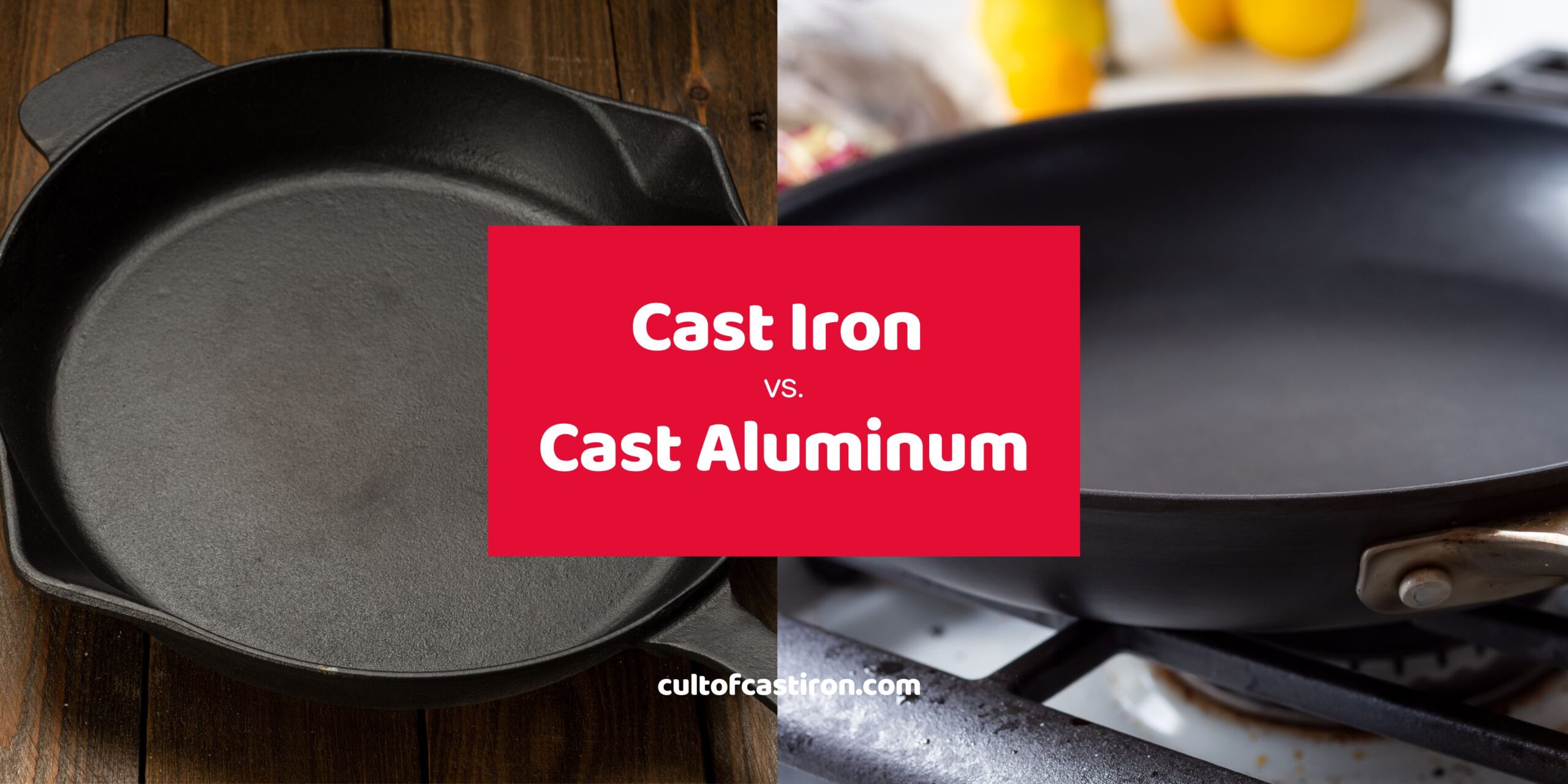You may have heard of cast iron skillets, but did you know that there is such a thing as cast aluminum pans, too?
Both materials have distinct benefits and drawbacks. They are so different that the word “cast” is probably the only thing similar between them. . Cast iron is celebrated for its durability and heat retention, while the newer-kid-on-the-block cast aluminum is prized for its lightweight nature and excellent heat conductivity.
These metallurgical differences also significantly impact their performance in the kitchen. Ultimately, the question you may be asking is: which material is better for home cooks?
This article aims to delve into the nuances of each material, comparing them across various factors such as heat conduction, durability, maintenance, and more, to help home cooks make an informed decision about which cookware suits their culinary needs best.
Cast Iron vs. Cast Aluminum: The Differences
In this guide, I will compare these two materials along the following aspects:
- History and Manufacturing
- Heat Conduction, Retention, and Distribution
- Versatility
- Durability and Maintenance
- Weight and Handling
- Non-stick Quality and Health Considerations
- Aesthetics
- Price and Availability
Deciding between cast iron pan and cast aluminum is a matter of personal preference and priorities. Consider what matters most and explore this comprehensive cast iron vs. cast aluminum guide to discover their differences.
History and Manufacturing
The history of cookware materials is as rich and varied as the culinary traditions they’ve helped shape. Cast iron cookware has a storied past, tracing its roots back to China in the 4th century B.C. The traditional method of casting iron involves pouring molten iron into sand molds, a technique that has remained largely unchanged for centuries.
Cast aluminum, on the other hand, entered the culinary scene much later. Its introduction in the early 20th century marked a significant advancement in cookware technology. Aluminum is cast using a similar method to iron but involves pouring molten aluminum into molds.
This manufacturing process means that both cast iron and cast aluminum can be shaped any which way you’d like, hence both materials can be made into skillets, grills, and even wafflers.
Heat Conduction, Retention, and Distribution
The performance of cookware in heat conduction, retention, and distribution is critical to its cooking performance, and this is where the fundamental differences between cast iron and cast aluminum become apparent.
| Material | Thermal Conductivity (W/mK) |
| Copper | 386 |
| Aluminum | 239 |
| Cast Iron | 55 |
| Carbon Steel | 45 |
| Stainless Steel | 25 |
Cast iron is renowned for its ability to retain heat, slowly absorbing and then radiating it evenly across its surface. This property makes it ideal for tasks requiring consistent temperatures over long periods, such as baking bread or slow-cooking stews. However, cast iron is slower to heat up and adjust to changes in temperature, which can be a drawback in situations requiring quick heat modifications.
Cast aluminum, in contrast, excels in heat conduction and distribution. It heats up rapidly and responds swiftly to temperature adjustments, offering chefs greater control for precision cooking. This makes it particularly suited for dishes that benefit from even heat distribution, like sauces and seared meats. However, it does not retain heat as well as cast iron, cooling down more quickly once removed from the heat source.
Versatility
The differences in these materials’ physical properties also play a part in their level of versatility in the kitchen.
Because of its high thermal capacity, cast iron cookware can be used on the stove, inside the oven, and even over open flames without cracking or warping. Its unparalleled heat retention properties make it ideal for high-heat searing, slow-cooked casseroles, and even artisanal bread baking. Iron itself is also magnetic, which means you can use it on an induction stove.
On the other hand, cast aluminum is not as heat-resistant as cast iron, and the high temperatures of open flame cooking may cause denting on an aluminum pan. Hence, it is usually relegated for stovetop cooking. Also, aluminum is not magnetic, and hence it cannot be used on an induction stove.
Durability and Maintenance
Durability and ease of maintenance are crucial factors that significantly influence the longevity and performance of cookware. In the context of these two materials, you’re going to have to choose between “highly durable but harder to maintain” and “not that durable but easier to maintain”.
Cast iron, known for its robustness, stands out as a beacon of durability in the kitchen. When properly maintained, cast iron cookware can last for generations, becoming a cherished heirloom passed down through families. This longevity is contingent upon regular seasoning—a process that not only protects the surface from rust and wear but also enhances its non-stick properties over time. However, cast iron does require a level of care and commitment; it must be dried immediately after washing and periodically re-seasoned to maintain its cooking surface.
Cast aluminum, while also durable, offers a different maintenance profile. It is naturally rust-resistant and generally easier to care for than cast iron, not requiring the same level of meticulous maintenance. Many cast aluminum pans come with a non-stick coating, which simplifies cleaning but also introduces a vulnerability to scratches and wear over time. The maintenance of cast aluminum cookware involves avoiding abrasive cleaning tools and harsh chemicals to preserve the integrity of its surface.
Weight and Handling
The weight of your cookware dictates which culinary techniques you can do with it (or at least, do comfortably and safely.)
Cast iron is renowned for its heft; its substantial weight is a testament to its durability and heat retention capabilities. This weight, however, can make techniques like tossing and the inverting onto a plate flipping method harder. Also, moving a full cast iron skillet or Dutch oven from stove to oven can be cumbersome, and the maintenance process—though straightforward—demands a bit of muscle to ensure the cookware is properly cleaned, dried, and seasoned.
In contrast, cast aluminum cookware is markedly lighter, making it a favorite for daily use among home cooks. The reduced weight facilitates easier handling, from stirring and flipping to transferring the pan between cooking surfaces. This accessibility makes cast aluminum an appealing option for those who value convenience and ease in their cooking routines. However, the lighter nature of aluminum doesn’t offer the same level of heat retention as cast iron, which can affect cooking outcomes for certain recipes that benefit from a slow, even heat.
Non-stick Quality and Health Considerations
The non-stick quality of cookware is a crucial factor for many home cooks, influencing both the cooking process and health considerations.
Cast iron, when properly seasoned and cared for, offers a naturally non-stick surface without the need for chemical coatings. This seasoning process involves baking oil into the cookware’s surface, creating a patina that improves with use. This natural non-stick capability means that food can be cooked with less oil, contributing to healthier cooking methods. Moreover, cooking with cast iron can increase the iron content of food, providing a dietary benefit, especially for those with iron deficiencies.
Cast aluminum cookware, on the other hand, often comes with a manufactured non-stick coating to prevent food from sticking. While this makes for easy cooking and cleaning, there are health concerns associated with some non-stick coatings, particularly those containing PFOA (perfluorooctanoic acid), which has been linked to several health issues. It is important for consumers to choose cast aluminum products with safe, high-quality non-stick surfaces that do not degrade at high temperatures.
Aesthetics
Aesthetics play a significant role in the selection of cookware, as many home chefs seek pieces that not only perform well but also complement the style of their kitchen.
Cast iron cookware boasts a timeless appeal, with its classic, rugged look that can range from a matte black finish to a glossy patina developed over years of seasoning and use. This aesthetic can enhance the rustic charm of a country kitchen or add a touch of traditional elegance to a modern setting. The visual appeal of cast iron, coupled with its functionality, often makes it a showpiece item, proudly displayed on stovetops or hung from ceiling racks.
Cast aluminum cookware, conversely, offers a more contemporary look, with sleek designs and often lighter colors that can blend seamlessly into modern kitchens. Many cast aluminum pieces are finished with vibrant enamels or advanced coatings that not only provide excellent non-stick properties but also add a pop of color to the cooking space. This variety allows for greater personalization in kitchen decor, enabling cooks to choose cookware that reflects their personal style and complements their home’s modern aesthetic.
Price and Availability
On its own, cast aluminum is cheaper than cast iron. However, when you factor in the Teflon coating of cast aluminum into the price, you’ll see that they will be more expensive than its cast iron counterpart.
Both cast iron and aluminum pans provide various options to accommodate different budgets. But if you’re going to buy only the dirt-cheap versions of each pan, you’re going to have a better time with an entry-level cast iron cookware than with a budget cast aluminum pan. These cast aluminum pans may have lower-quality non-stick coating that is prone to wear out or may break easily due to compromises in the manufacturing process.
On the other hand, cheap cast iron can still give you a good cooking performance, and it can still last you a lifetime with proper care and maintenance.
Team Cast Iron or Team Cast Aluminum?
Individual preferences hold significant weight when selecting the perfect cookware for your culinary adventures. Cast iron may give you a good cooking performance and an almost lifetime durability guarantee, but you can’t deny the convenience that cast aluminum cookware provides, and its hassle free ownership may be just what you’re looking for. But if you ask me which one I’d prefer, well, just look at the name of this website.
If you’re eager to level up your cast iron cookware game, look no further than the Cult of Cast Iron! We’ve got all the tricks, handy tips, and practical advice to turn you into a cast iron master. Need a review, a guide, or the hottest recommendations? We’ve got your back! Explore our blog and join the Cult of Cast Iron today!

Miguel is a cast iron enthusiast from Cavite, Philippines. He works in the digital marketing field as a content marketing strategist. On the side, he manages a small online bookstore and tends to his plants.

